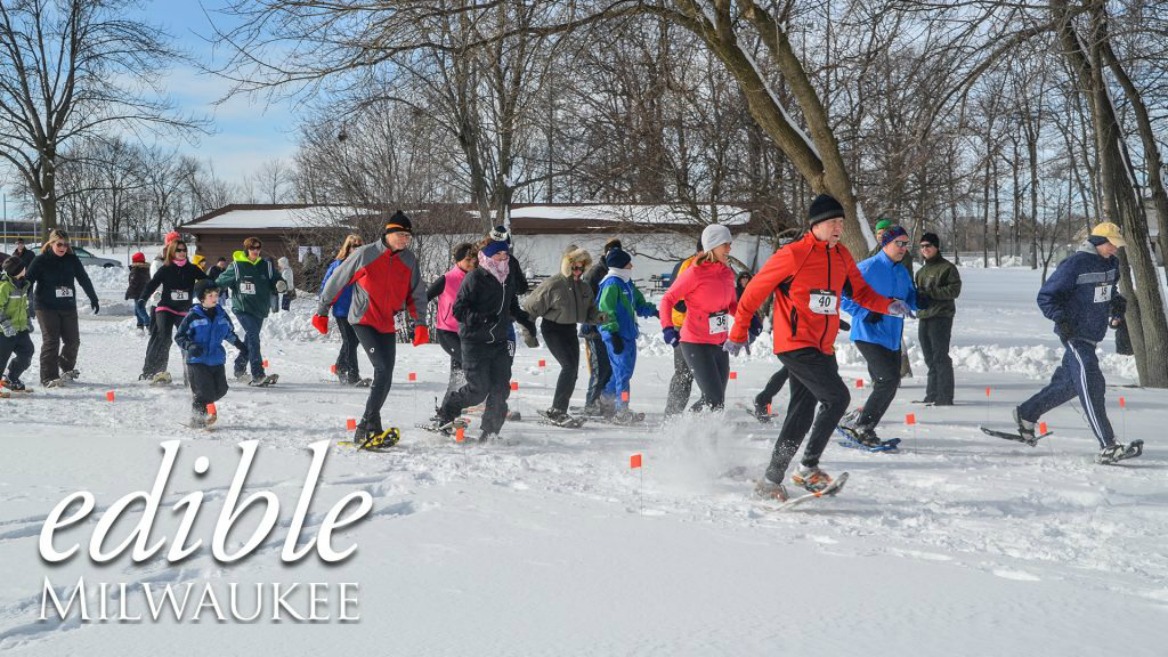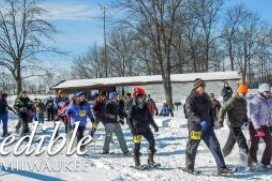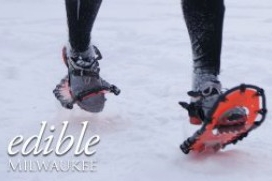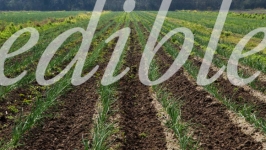Ready. Set. Snow!
Walk a Mile in Snowshoes Before Judging Winter Racing
I got cabin fever … and the only prescription is more snow. Because when it comes to that cooped up feeling that sets in shortly after the holidays wane, there is only one cure: to buckle into some snowshoes.
For thousands of years, humans have used devices shaped like rackets as footwear to traverse across deep, powdery snowfields. It’s hard to say who invented them first, as historical records present evidence of simultaneous discoveries in different regions of the globe. So let’s just say, at multiple points in time, people figured out that distributing your weight over a large flat device would prevent your feet from sinking in the snow, a term now called “floatation.”
Such contrivances were originally crafted from wood frames and hide netting. They were utilized for voyaging, hunting, trading, and even marching into war (e.g. the Battle on Snowshoes during the French and Indian War in the 18th century).
Over time, their elongated designs, which some say stretched up to 7 feet long, evolved to mimic the paws of animals that travel with ease in wintery climates. The snowshoe hare with its oversized hind feet is perhaps the most fitting example. Then there’s the modified bear-paw style, short and wide with a narrow swallowtail, making it suitable for long-distance hikes in dense snow. Other traditional styles are named after the tribes that crafted them, such as the Huron, Alaskan and Ojibwa, each with distinct curves and features modeled to meet various weather conditions.
These traditional apparatuses continued to be manufactured well into the 20th century. Then, in the early ’70s, a radical change in snowshoe engineering pioneered technological advances that would lead to the snowshoes of the millennium. Not coincidentally, the first organized snowshoe races were kicking off in Europe at the same time.
The new designs were shorter, lighter and made with lightweight aluminum fit for space travel. Nylon replaced hide, and cleats and bindings were added to the frames. Refined further by more convenient buckles, flexible toe rotations and heel lift features for support and relief while trekking uphill, the snowshoe hare models of yesterday were relegated to cabin walls.
Today, backpackers, hikers, walkers, and winter runners use snowshoes much like skis, for sheer recreation. If you’re considering trying them for the first time, you’ll soon know why.
Dashing Through the Snow
With more year-round runners ditching the indoor track and treadmill, snowshoe races are popping up across the country, Milwaukee included—and yes, there’s a snowshoe designed specifically for racing, too. Generally, running snowshoes are smaller, since most races take place along groomed trails, and a more natural gait takes priority over floatation.
To say the popularity of snowshoeing has spiked in the last decade would be putting it lightly. According to the 2016 Outdoor Recreation Participation Topline Report, snowshoeing is up more than 60 percent since 2007. Nearly 4 million participants see snowshoeing as a remedy for winter wanderlust. “It’s a great way to get a different look at Wisconsin’s beautiful outdoors,” says Ed Neckar. He’s the past president of the Prospect Lions Club, who will be hosting the 2017 Snowshoe Roar in New Berlin on January 28. “Anyone can sign up. We’ve had racers from their teens to their 70s,” he says.
The event attracts a good mix of newcomers and long-time snowshoers. Neckar, a 20-year veteran on snowshoes has competed several times himself, but you won’t find him racing this year. Instead, he’ll serve as a guide to help blind snowshoers complete the course.
At Riveredge Nature Center in Saukville, Adventure Education Manager Steff Merten leads guided snowshoe hikes. “For most families, guided programs are their first introduction to snowshoeing,” Merten says. Without any initial instruction, “some people feel as though they’re strapping tennis rackets to their feet and hoping for the best,” she says. “Our goal is to make the experience easy and enjoyable.”
Guides discuss the pros and cons of different snowshoe styles and their historical significance before turning the crowd loose for practice in an open area. “Then we’re off to the races!” Merten says, only somewhat joking. Every year, Riveredge hosts the Sugar Dragon Scurry Snowshoe 5K. Participants race through the forest while learning about the elusive “Sugar Dragon” that collects sap from the maple trees. The 2017 event will take place January 29, starting at noon. Like most races, all ages are welcome.
Riveredge offers candlelit snowshoe hikes, too. So, um, what are you doing Friday night? From 5:00–8:00 p.m. every Friday in January and February, Riveredge welcomes members and nonmembers to enjoy the 1.5-mile trail gently illuminated by lanterns and starlight. The cost is a modest $5 for nonmembers and free for members. Snowshoe rentals are also available for $10 an hour for nonmembers; $5 an hour for members.
Eat Up. Drink Up.
While it’s true that “if you can walk, you can snowshoe,” it’s certainly a more intense workout than going for a stroll. Depending on your pace and the terrain, snowshoeing can burn between 400 and 1,000 calories per hour. Plus, your body is using more energy to stay warm on those shivery days.
Most organized snowshoe races in town, including the Snowshoe Roar and Sugar Dragon Scurry, end with hot chili or pancakes and a warm beverage to help you thaw out and refuel. But if you’re venturing out on your own, don’t forget to pack snacks and water—and plenty of it. Compared to hot, humid conditions, you actually need more water when the temps are frigid. To prevent dehydration, start drinking water a few hours before you plan to strap on the snowshoes and try to drink at least two cups of water per hour of activity.
Carrying a thermos of hot soup or cider is always worth the extra weight and will help cut through the winter chill. Other easy-to-pack lightweight items are trail mix, tangerines, dried fruit, energy bars, and granola. Remember, your body needs fuel to stay warm.
On a mild, sunny day when there’s still a blanket of snow draped across the park, a winter picnic via snowshoe will help reverse a case of S.A.D. (Seasonal Affective Disorder). Fill up those backpacks with baguettes, jams, cheeses, fresh fruit, something chocolate and make a day of feasting like a yeti, assuming yetis have a palate for simple French fare.
Snowshoe Rentals
Snowshoe rentals are available at the following locations. Please call for reservations and details.
Havenwoods State Forest: 414-527-0232
Riveredge Nature Center: 262-375-2715
Urban Ecology Centers
Riverside Park: 414-964-8505
Washington Park: 414-344-5460
Menomonee Valley: 414-431-2940
Wehr Nature Center: 414-425-8550
Whitnall Park Winter Clubhouse Concessions & Rentals: 414-525-4765









